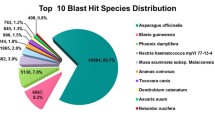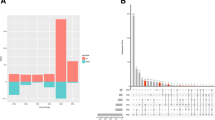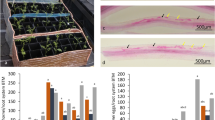Abstract
Main conclusion
Transcriptome analysis was performed on the roots of susceptible and resistant sweetpotato cultivars infected with the major root-knot nematode species Meloidogyne incognita. In addition, we identified a transcription factor-mediated defense signaling pathway that might function in sweetpotato–nematode interactions.
Root-knot nematodes (RKNs, Meloidogyne spp.) are important sedentary endoparasites of many agricultural crop plants that significantly reduce production in field-grown sweetpotato. To date, no studies involving gene expression profiling in sweetpotato during RKN infection have been reported. Therefore, in the present study, transcriptome analysis was performed on the roots of susceptible (cv. Yulmi) and resistant (cv. Juhwangmi) sweetpotato cultivars infected with the widespread, major RKN species Meloidogyne incognita. Using the Illumina HiSeq 2000 platform, we generated 455,295,628 pair-end reads from the fibrous roots of both cultivars, which were assembled into 74,733 transcripts. A number of common and unique genes were differentially expressed in susceptible vs. resistant cultivars as a result of RKN infection. We assigned the differentially expressed genes into gene ontology categories and used MapMan annotation to predict their functional roles and associated biological processes. The candidate genes including hormonal signaling-related transcription factors and pathogenesis-related genes that could contribute to protection against RKN infection in sweetpotato roots were identified and sweetpotato–nematode interactions involved in resistance are discussed.







Similar content being viewed by others
Abbreviations
- DEG:
-
Differentially expressed genes
- ET:
-
Ethylene
- JA:
-
Jasmonic acid
- PR:
-
Pathogenesis-related
- RKN:
-
Root-knot nematode
- SA:
-
Salicylic acid
- TF:
-
Transcription factor
References
Abe H, Urao T, Ito T, Seki M, Shinozaki K, Yamaguchi-Shinozaki K (2003) Arabidopsis AtMYC2 (bHLH) and AtMYB2 (MYB) function as transcriptional activators in abscisic acid signaling. Plant Cell 15:63–78
Anderson JP, Badruzsaufari E, Schenk PM, Manners JM, Desmond OJ, Ehlert C, Maclean DJ, Ebert PR, Kazan K (2004) Antagonistic interaction between abscisic acid and jasmonate-ethylene signaling pathways modulates defense gene expression and disease resistance in Arabidopsis. Plant Cell 16:3460–3479
Asai T, Tena G, Plotnikova J, Willmann MR, Chiu WL, Gomez-Gomez L, Boller T, Ausubel FM, Sheen J (2002) MAP kinase signalling cascade in Arabidopsis innate immunity. Nature 415:977–983
Boter M, Ruiz-Rivero O, Abdeen A, Prat S (2004) Conserved MYC transcription factors play a key role in jasmonate signaling both in tomato and Arabidopsis. Genes Dev 18:1577–1591
Branch C, Hwang CF, Navarre DA, Williamson VM (2004) Salicylic acid is part of the Mi-1-mediated defense response to root-knot nematode in tomato. Mol Plant Microbe Int 17:351–356
Bridge J, Starr JL (2010) Plant nematodes of agricultural importance a color handbook. Academic Press, San Diego, pp 77–78
Camera SL, Balagué C, Göbel C, Geoffroy P, Legrand M, Feussner I, Roby D, Heitz T (2009) The Arabidopsis patatin-like protein 2 (PLP2) plays an essential role in cell death execution and differentially affects biosynthesis of oxylipins and resistance to pathogens. Mol Plant Microbe Int 22:469–481
Castagnone-Sereno P, Danchin EG, Perfus-Barbeoch L, Abad P (2013) Diversity and evolution of root knot nematodes, genus Meloidogyne: new insights from the genomic era. Annu Rev Phytopathol 51:203–220
Cervantes-Flores JC, Yenchom GC, Pecotam KV, Sosinski B (2008) Detection of quantitative trait loci and inheritance of root-knot nematode resistance in sweetpotato. J Am Soc Hortic Sci 133:844–851
Choi DR, Lee JK, Park BY, Chung MN (2006) Occutrrence of rootknot nematodes in sweet potato fields and resistance screening of sweet potato cultivars. Korean J Appl Entomol 45:211–216
Clark CA, Moyer JW (1998) Compendium of sweetpotato diseases. APS Press, Saint Paul
De Vos M, Van Oosten VR, Van Poecke RM, Van Pelt JA, Pozo MJ, Mueller MJ, Buchala AJ, Metraux JP, Van Loon LC, Dicke M, Pieterse CMJ (2005) Signal signature and transcriptome changes of Arabidopsis during pathogen and insect attack. Mol Plant Microbe In 18:923–937
Diaz JT, Chinn MS, Truong VD (2014) Simultaneous saccharification and fermentation of industrial sweetpotatoes for ethanol production and anthocyanins extraction. Ind Crops Prod 62:53–60
Dombrecht B, Xue GP, Sprague SJ, Kirkegaard JA, Ross JJ, Reid JB, Fitt GP, Sewelam N, Schenk PM, Manners JM, Kazan K (2007) MYC2 differentially modulates diverse jasmonate-dependent functions in Arabidopsis. Plant Cell 19:2225–2245
Eulgem T, Somssich IE (2007) Networks of WRKY transcription factors in defense signaling. Curr Opin Plant Biol 10:366–371
Fu L, Niu B, Zhu Z, Wu S, Li W (2012) CD-HIT: accelerated for clustering the next-generation sequencing data. Bioinformatics 28:3150–3152. https://doi.org/10.1093/bioinformatics/bts565
Fujita M, Fujita Y, Noutoshi Y, Takahashi F, Narusaka Y, Yamaguchi-Shinozaki K, Shinozaki K (2006) Crosstalk between abiotic and biotic stress responses: a current view from the points of convergence in the stress signaling networks. Curr Opin Plant Biol 9:436–442
Grace MH, Yousef GG, Gustafson SJ, Truong VD, Yencho GC, Lila MA (2014) Phytochemical changes in phenolics, anthocyanins, ascorbic acid, and carotenoids associated with sweetpotato storage and impacts on bioactive properties. Food Chem 145:717–724
Grunewald W, Karimi M, Wieczorek K, Van de Cappelle E, Wischnitzki E, Grundler F, Inzé D, Beeckman T, Gheysen G (2008) A role for AtWRKY23 in feeding site establishment of plant-parasitic nematodes. Plant Physiol 148:358–368
Ha J, Won JC, Jung YH, Yang JW, Lee HU, Nam KJ, Park SC, Jeong JC, Lee SW, Lee DW, Chung JS, Lee JJ, Kim YH (2017) Comparative proteomic analysis of the response of fibrous roots of nematode-resistant and -sensitive sweetpotato cultivars to root-knot nematode Meloidogyne incognita. Acta Physiol Plant 39:262. https://doi.org/10.1007/s11738-017-2560-0
Hamamouch N, Li C, Seo PJ, Park CM, Davis EL (2011) Expression of Arabidopsis pathogenesis-related genes during nematode infection. Mol Plant Pathol 12:355–364
Han Z, Sun Y, Chai J (2014) Structural insight into the activation of plant receptor kinases. Curr Opin Plant Biol 20:55–63
Holbein J, Grundler FMW, Siddique S (2016) Plant basal resistance to nematodes: an update. J Exp Bot 67:2049–2061
Jones JD, Dangl JL (2006) The plant immune system. Nature 444:323–329
Kadota Y, Sklenar J, Derbyshire P, Stransfeld L, Asai S, Ntoukakis V, Jones JD, Shirasu K, Menke F, Jones A, Zipfel C (2014) Direct regulation of the NADPH oxidase RBOHD by the PRR-associated kinase BIK1 during plant immunity. Mol Cell 54:43–55
Kazan K, Manners JM (2008) Jasmonate signaling: toward an integrated view. Plant Physiol 146:1459–1468
Kistner MH, Daiber KC, Bester C (1993) The effect of root-knot nematodes (Meloidogyne spp.) and dry land conditions on the production of sweetpotato. JS Afr Soc Hortic Sci 3:108–110
Kreuze J (2002) Molecular studies on the sweetpotato virus disease and its two causal agents. In: Acta Universitatis Agriculturae Sueciae Agraria 335. Department of Plant Biology, Sveriges lantbrukuniversitet, Uppsala
Lee JJ, Park KW, Kwak YS, Ahn JY, Jung YH, Lee BH, Jeong JC, Lee HS, Kwak SS (2012) Comparative proteomic study between tuberous roots of light orange- and purple-fleshed sweetpotato cultivars. Plant Sci 193–194:120–129
Li L, Li M, Yu L, Zhou Z, Liang X, Liu Z, Cai G, Gao L, Zhang X, Wang Y, Chen S, Zhou JM (2014) The FLS2-associated kinase BIK1 directly phosphorylates the NADPH oxidase RbohD to control plant immunity. Cell Host Microbe 15:329–338
Liu JJ, Ekramoddoullah AKM (2006) The family 10 of plant pathogenesis-related proteins: their structure, regulation, and function in response to biotic and abiotic stresses. Physiol Mol Plant Pathol 68:3–13
Lorenzo O, Chico JM, Sanchez-Serrano JJ, Solano R (2004) JASMONATE-INSENSITIVE1 encodes a MYC transcription factor essential to discriminate between different jasmonate-regulated defense responses in Arabidopsis. Plant Cell 16:1938–1950
Lu DP, Wu SJ, Gao XQ, Zhang YL, Shan LB, He P (2010) A receptor-like cytoplasmic kinase, BIK1, associates with a flagellin receptor complex to initiate plant innate immunity. Proc Natl Acad Sci USA 107:496–501
Melillo MT, Leonetti P, Bongiovanni M, Castagnone-Sereno P, Bleve-Zacheo T (2006) Modulation of reactive oxygen species activities and H2O2 accumulation during compatible and incompatible tomato-root knot nematode interactions. New Phytol 170:501–512
Mendy B, Wangombe MW, Radakovic ZS, Holbein J, Ilyas M, Chopra D, Holton N, Zipfel C, Grundler FMW, Siddique S (2017) Arabidopsis leucine-rich repeat receptor-like kinase NILR1 is required for induction of innate immunity to parasitic nematodes. Plos Pathol 13:e1006284
Nahar K, Kyndt T, De Vleesschauwer D, Hofte M, Gheysen G (2011) The jasmonate pathway is a key player in systemically induced defense against root knot nematodes in rice. Plant Physiol 157:305–306
Nandi B, Kundu K, Banerjee N, Babu SPS (2003) Salicylic acid-induced suppression of Meloidogyne incognita infestation of okra and cowpea. Nematology 5:747–752
Palomares-Rius JE, Kikuchi T (2013) Omics fields of study related to plant-parasitic nematodes. J Integr Omics 3:1–10
Park SC, Kim YH, Ji CY, Park S, Jeong JC, Lee HS, Kwak SS (2012) Stable internal reference genes for the normalization of real-time PCR in different sweetpotato cultivars subjected to abiotic stress conditions. PLoS ONE 7:e51502
Peng HC, Kaloshian I (2014) The tomato leucine-rich repeat receptor-like kinases SISERK3A and SISERK3B have overlapping functions in bacterial and nematode innate immunity. PLoS ONE 9:e93302
Roux M, Schwessinger B, Albrecht C, Chinchilla D, Jones A, Holton N, Malinovsky FG, Tor M, de Vries S, Zipfel C (2011) The Arabidopsis leucine-rich repeat receptor-like kinases BAK1/SERK3 and BKK1/SERK4 are required for innate immunity to hemibiotrophic and biotrophic pathogens. Plant Cell 23:2440–2455
Rushton PJ, Somssich IE, Ringler P, Shen QJ (2010) WRKY transcription factors. Trends Plant Sci 15:247–258
Santino A, Taurino M, De Domenico S, Bonsegna S, Poltronieri P, Pastor V, Flors V (2013) Jasmonate signaling in plant development and defense response to multiple (a)biotic stresses. Plant Cell Rep 32:1085–1098
Soriano I, Riley I, Potter M, Bowers W (2004) Phytoecdysteroids: a novel defense against plant-parasitic nematodes. J Chem Ecol 30:1885–1899
Staswick PE, Yuen GY, Lehman CC (1998) Jasmonate signaling mutants of Arabidopsis are susceptible to the soil fungus Pythium irregulare. Plant J 15:747–754
Sun YD, Li L, Macho AP, Han ZF, Hu ZH, Zipfel C, Zhou JM, Chai JJ (2013) Structural basis for flg22-induced activation of the Arabidopsis FLS2-BAK1 immune complex. Science 342:624–628
Teixeira MA, Wei L, Kaloshian I (2016) Root-knot nematodes induce pattern- triggered immunity in Arabidopsis thaliana roots. New Phytol 211:279–287
Thomma BPHJ, Eggermont K, Penninckx IAMA, Mauch-Mani B, Vogelsang R, Cammue BPA, Broekaert WF (1998) Separate jasmonate-dependent and salicylate-dependent defense-response pathways in Arabidopsis are essential for resistance to distinct microbial pathogens. Proc Natl Acad Sci USA 95(15107–15):111
Van Loon LC, Rep M, Pieterse CMJ (2006) Significance of inducible defense-related proteins in infected plants. Ann Rev Phytopathol 44:135–162
Viaene N, Smol N, Bert W (2012) General techniques in nematology. Academia Press, Gent. Belgium, pp 58–59
Vijayan P, Shockey J, Levesque CA, Cook RJ, Browse J (1998) A role for jasmonate in pathogen defense of Arabidopsis. Proc Natl Acad Sci USA 95:7209–7214
Williamson VM, Kumar A (2006) Nematode resistance in plants: the battle underground. Trends Genet 22:396–403
Woolfe JA (1992) Sweetpotato: an untapped food resource. Cambridge University Press, Cambridge
Yeh KW, Lin MI, Tuan SJ, Chen YM, Lin CY, Kao SS (1997) Sweetpotato (Ipomoea batatas) trypsin inhibitors expressed in transgenic tobacco plants confer resistance against Spodoptera litura. Plant Cell Rep 16:696–699
Zipfel C (2008) Pattern-recognition receptors in plant innate immunity. Curr Opin Immunol 20:10–16
Zipfel C (2014) Plant pattern-recognition receptors. Trends Immunol 35:345–351
Acknowledgements
This research was supported by the Basic Science Research Program through the National Research Foundation of Korea (NRF) funded by the Ministry of Science, ICT, and Future Planning (2018R1A1A1A05018446).
Author information
Authors and Affiliations
Corresponding author
Electronic supplementary material
Below is the link to the electronic supplementary material.
Rights and permissions
About this article
Cite this article
Lee, I.H., Shim, D., Jeong, J.C. et al. Transcriptome analysis of root-knot nematode (Meloidogyne incognita)-resistant and susceptible sweetpotato cultivars. Planta 249, 431–444 (2019). https://doi.org/10.1007/s00425-018-3001-z
Received:
Accepted:
Published:
Issue Date:
DOI: https://doi.org/10.1007/s00425-018-3001-z




